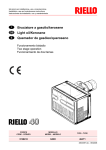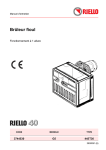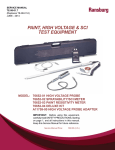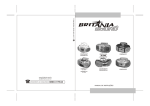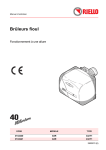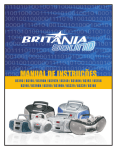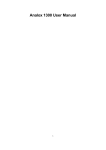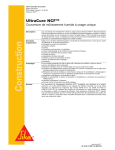Download Riello G20KI Technical data
Transcript
Installation, use and maintenance instructions Light oil - kerosene burner One stage operation CODE MODEL TYPE 3747455 G20KI 474T52 2902403 (4) - 01/2008 TECHNICAL DATA Thermal power – output 95 – 213 kW – 8 – 18 kg/h Fuel Light oil and kerosene Electrical supply single phase, Motor run current 1.4 A – 2750 rpm – 288 rad/s Capacitor 5 μF Ignition transformer secondary 8 kV – 16 mA Pump maximum pressure 14 bar (203 psi) Absorbed electrical power 0.32 kW 240 V + 10% – 15% ~ 50Hz Q Burner with CE marking in conformity with EEC Directives: EMC89/336/EEC - 2004/108/EC, Low Voltage 73/23/EEC - 2006/95/EC, Machines 98/37/EEC and Efficiency 92/42/EEC. Q The burner meets protection level of IP 40, EN 60529. 10 Fig. 1 7 6 8 6 4 9 D8067 3 1 – Return line 2 1 BURNER EQUIPMENT 2 – Suction line 3 – Gauge connection Quantity 4 – Pump pressure regulator 2 1 4 1 1 1 5 – Vacuum gauge connection 6 – Screws fixing air-damper 7 – Hydraulic jack with air-damper 8 – Lock-out lamp and reset button 7 – Flange with insulating gasket 10 – Combustion head adjustment screw 2403 1 Description Flexible pipes with nipples Flange with insulating gasket Screws and nuts for flange Maintenance assembly Cable gland Screw with two nuts for flange 5 Pressure in the combustion chamber – mbar FIRING RATE 1.8 1.2 0.6 0 8 90 D5282 10 110 12 130 14 150 16 170 190 18 20 Fuel output - kg/h 210 230 Thermal power - kW OVERALL DIMENSIONS Flange Burner 350 213 118 ø 125 230 298 99 11 45° 160 295 = 99 45° = 190 41 2403 2 D5283 INSTALLATION BOILER FIXING ³ Put on the flange (1) the screw and two nuts, (see fig. 2). ³ Widen, if necessary, the insulating gasket holes (5), (see fig. 3). ³ Fix the flange (1) to the boiler door (4) using screws (2) and (if necessary) the nuts (3) interposing the insulating gasket (5), (see fig. 4). MAINTENANCE POSITION Access to the combustion head, diffuser disc / electrodes unit and nozzle, (see fig. 5). ³ Remove the burner out of the boiler, after loosing the fixing nut to the flange. ³ Hook the burner to the flange (1), by removing the combustion head (6) after loosing the fixing screws (7). ³ Remove the diffuser disc-holder assembly (9) from the nozzle-holder (8) after loosing its fixing screw. ³ Screw the nozzle (10). 4 5 Fig. 4 Fig. 3 Fig. 2 2 5 1 D5012 2 1 E9022 D8058 1 5 2 6 4 Fig. 5 3 D8056 D8057 Verify that the installed burner is lightly leaned towards the button. (See figure 6). Fig. 6 The burner is designed to allow entry of the flexible oil-lines on either side of the burner. D5572 2403 3 3 HYDRAULIC SYSTEM WARNING ONLY FOR TWO PIPE SYSTEM: before starting the burner make sure that the return pipe-line is not clogged: any obstruction would cause the pump seals to break. WARNING: The pump is supplied for use with a one pipe system. For use on a two pipe system, it is necessary to screw the by-pass screw (A), hang up to the pump. L meters max. 4 m H D5219 min. 0.1 m H meters I.D. 10 mm 10 20 40 60 20 40 80 100 A D5199 max. 4 m H H = Difference of level. L = Max. length of the suction line. I.D.= Internal diameter of the oil pipes. D5220 0.5 1 1.5 2 I. D. 8 mm PRIMING THE PUMP Loosen the plug of the vacuum gauge (5, fig. 1) and wait until the fuel flows out. L meters H meters 0 0.5 1 1.5 2 3 3.5 I. D. 8 mm I.D. 10 mm 35 30 25 20 15 8 6 100 100 100 90 70 30 20 The pump vacuum should not exceed a maximum of 0.4 bar (30 cm Hg). Beyond this limit gas is released from the oil. Oil lines must be completely airtight. The return line should terminate in the oil tank at the same level as the suction line; in this case a non-return valve is not required. When the return line arrives over the fuel level, a non-return valve must be used. This solution however is less safe than previous one, due to the possibility of leakage of the valve. H PRIMING THE PUMP: Start the burner and wait for the priming. Should lock-out occur prior to the arrival of the fuel, await at least 20 seconds before repeating the operation. X X A metal bowl filter with replaceable micronic filter must be fitted in the oil supply pipe. Check periodically the flexible pipes conditions. Using kerosene, they have to be replaced at least every 2 years. 2403 4 BURNER ELECTRICAL WIRING 240V N ~ 50Hz L WARNING Do not exchange the neutral with the phase. Main switch Neutral T6A 4 5 6 Blue Valve Black Capacitor T Safety thermostat 7 8 9 Terminal block of control-box 530SE * Brown 3 L White (50V) 2 Limit thermostat Remote lock-out signal (240V - 0.5A max.), if required Blue 1 Brown Black CARRIED-OUT IN THE FACTORY N T M ~ Motor D5228 NOTES – Wires of 1 mm2 section. – The electrical wiring carried out by the installer must be in compliance with the rules in force in the Country. – To remove the control-box from the burner, loosen screw (A) (see figure) and pull towards the arrow. – The photoresistance is fitted directly into the control-box (underneath the ignition-transformer) on a plug-in support. TESTING Check the shut-down of the burner by opening the thermostats. 2403 5 S7029 RUN OF THE ELECTRICAL CABLE 1 - Cable gland 2 - Cable-clamp 3 - Terminal block N - Neutral L - Phase - Burner-earth COMBUSTION ADJUSTMENT In conformity with Efficiency Directive 92/42/EEC the application of the burner on the boiler, adjustment and testing must be carried out observing the instruction manual of the boiler, including verification of the CO and CO2 concentration in the flue gases, their temperatures and the average temperature of the water in the boiler. To suit the required appliance output, fit the nozzle then adjust the pump pressure, the setting of the combustion head and the air damper opening in accordance with the following schedule. FUEL LIGHT OIL 1 2 Nozzle Pump pressure Burner output bar 12 12 12 12 12 12 13 kg/h ± 4% 8.6 9.7 10.7 12.9 15.0 17.2 17.9 GPH 2.00 2.25 2.50 3.00 3.50 4.00 4.00 Angle 60° 60° 60° 60° 60° 60° / 45° 60° / 45° 3 4 Comb. head adjustment Set-point 1 1.5 2 2.5 3.5 5 6 Air damper adjustment Set-point 3 3.2 3.5 4.3 5.5 6.5 7 3 4 Comb. head adjustment Set-point 0.5 1 1.5 2.5 3 3.5 5 6 Air damper adjustment Set-point 2.2 2.4 3.0 3.2 4.0 6.0 6.5 7.0 FUEL KEROSENE GPH 2.75 3.00 3.50 4.00 4.50 5.00 5.50 6.00 1 1 2 Nozzle Pump pressure Burner output bar 8 8 8 8 8 8 8 8 kg/h ± 4% 8.1 8.9 10.3 11.8 13.3 14.8 16.2 17.7 Angle 60° 60° 60° 60° 60° 60° 60° / 45° 60° / 45° NOZZLES RECOMMENDED: Monarch type R - PLP; Delavan type B - W Steinen type S - SS ; Danfoss type S - B Angle 60°: in most cases. Particularly suitable to avoid flame-detachment during ignition. 45°: for narrow and long combustion-chamber. 2 PRESSURE: 8 bar: the pump leaves the factory set at this value, which is suitable only for kerosene. 10 bar: maximum pressure for kerosene. FOR LIGHT OIL INCREASE PRESSURE 12 bar: in most cases. 14 bar: improves flame retention; it is therefore suitable for ignitions at low temperatures. 2403 6 3 COMBUSTION HEAD SETTING This is done when fitting the nozzle, with the blast tube removed. It depends on the output of the burner and is carried out by rotating the regulating rod, till the terminal plane of the blast tube is level with the set-point, as indicated in the schedule. In the sketch below, the combustion head is set for an output of 3.50 GPH at 12 bar (for light oil) or 5.00 GPH at 8 bar (for kerosene). The shutter is level with set-point 3.5, as required by the schedule at page 6. 2 Terminal plane of the blast tube 3 1 6 2 5 3 1 Regulating rod D5676 Blast tube Shutter D8068 Combustion head settings indicated in the schedule are valid for most cases. The setting of the fan output according to the installation should normally be done only through the air damper. Should one subsequently want to retouch also the setting of the combustion head, with the burner running, operate on the rod (1) with a 6 mm spanner (2) as follows: TURN TO THE RIGHT: (SIGN +) In order to increase the volume of air entering the combustion chamber and thus diminishing its pressure. There is a reduction of CO2 and the adhesion of the flame to the air diffuser disc improves. (Setting advisable for ignitions at low temperatures). TURN TO THE LEFT: (SIGN –) In order to reduce the volume of air entering the combustion chamber and thus increasing its pressure. The CO2 improves and the adhesion of the flame to the diffuser tends to reduce. (This setting is not advisable for ignitions at low temperatures). In any case do not bring the combustion head setting more than one point away from that indicated in the schedule. One set-point corresponds to 3 turns of the rod; a hole (3) at its end facilitates counting the number of turns. 2403 7 4 AIR DAMPER ADJUSTMENT: 1 2 The mobile air damper (1) operated by the jack (2) assures the complete opening of the air intake. The regulation of the air-rate is made by adjusting the fixed air damper (3), after loosing the screws (4). When the optimal regulation is reached, screw tight the screws (4) to assure a free movement of the mobile air damper (1). 3 The settings indicated in the schedule refer to the burner with its metal cover fitted and the combustion chamber with “zero” depression. These regulations are purely indicative. Each installation however, has its own unpredictable working conditions: actual nozzle output; positive or negative pressure in the combustion-chamber, the need of excess air, etc. All these conditions may require a different air-damper setting. It is important to take account of the fact that the air output of the fan differs according to whether the burner has its metal cover fitted or not. 4 4 D5550 PANEL Therefore we recommended to proceed as follows: – adjust the air damper as indicated in the schedule (4); – mount the cover, simply by means of the upper screw; – check smoke number; – should it become necessary to modify the air output, remove the cover by loosening the screw, adjust the air damper, remount the cover and finally recheck the smoke number. NOTE: When the burner works at a firing rate higher than 17 kg/h remove the panel fitted inside the metal cover (see figure). D5682 ELECTRODE SETTING Attention: Before assembling or removing the nozzle, loosen the screw (A) and move the electrodes ahead. MOVE THE ELECTRODE HOLDER BACKWARDS TO THE END 4 ± 0.3 mm D5288 A 2403 8 6.5 ± 0.5 mm START-UP CYCLE Normal Lock-out, due to light-failure Thermostat Motor Ignition transformer Valve Flame Lock-out lamp ~ 12s ~ 12s ~ 5s D5229 ONLY FOR LIGHT OIL ADJUSTMENTS TO AVOID FLAME DETACHMENT AT BURNER IGNITION 1) CORRECT POSITIONING OF THE ELECTRODES MOVE THE ELECTRODE HOLDER BACKWARDS TO THE END 4 ± 0.3 mm D5288 A 2) NOZZLE: ATOMIZING ANGLE: Choose 60° nozzle. 3) PUMP - SETTING 6.5 ± 0.5 mm When the temperature of the light oil decreases below +5 °C, increase the pressure to 14 bar. 4) COMBUSTION-HEAD SETTING Regulate the combustion-head one set-point further ahead than indicated in the instructions. Example: the instructions require to set the combustion-head on set-point 2.5. Instead, the setting is made on set-point 3.5. 5) FAN - AIR DAMPER ADJUSTMENT Adjust the damper, reducing the excess air until the Bacharach number is not near 1. (i.e. a combustion with the lowest possible excess-air). 2403 9 RIELLO S.p.A. I-37045 Legnago (VR) Tel.: +39.0442.630111 http:// www.rielloburners.com Subject to modifications












